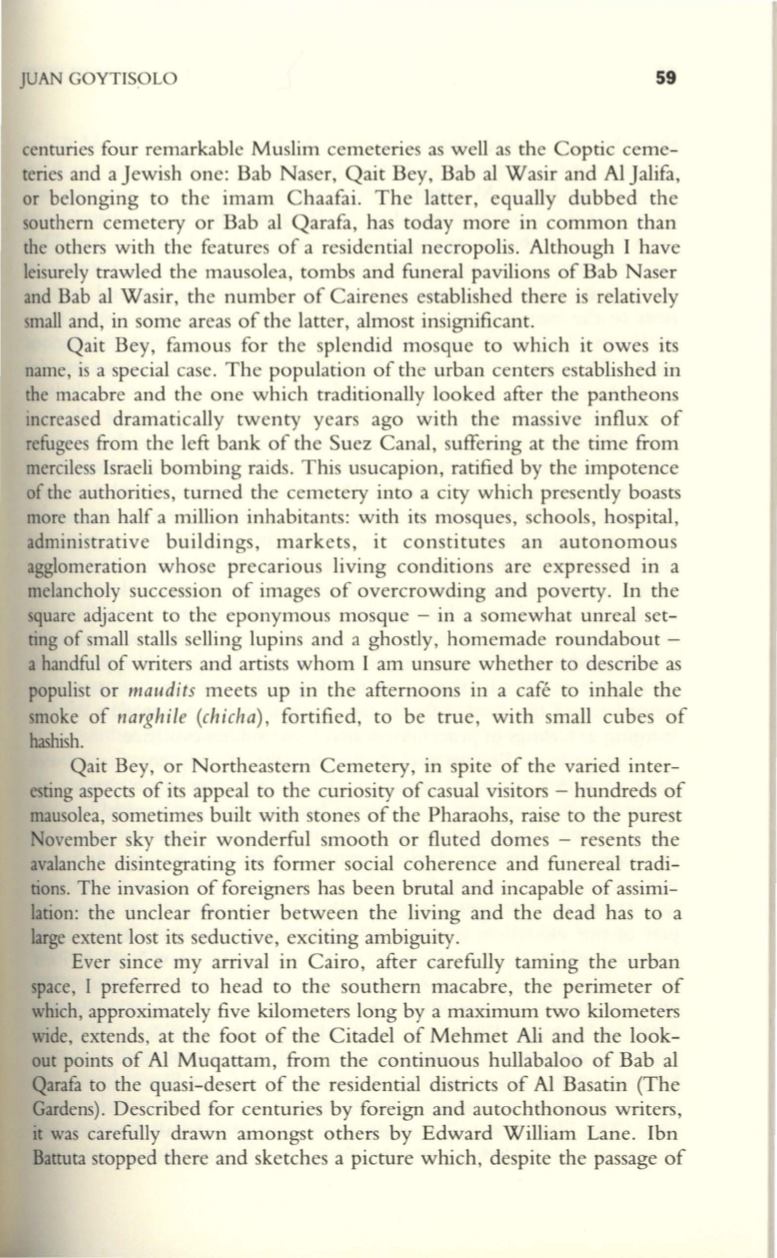
JUAN GOYTISOLO
59
centuries four remarkable Muslim cemeteries as well as the Coptic ceme–
teries and a Jewish one: Bab Naser, Qait Bey, Bab al Wasir and AI Jalifa,
or belonging to the imam Chaafai. The latter, equally dubbed the
southern cemetery or Bab al Qarafa, has today more in common than
the others with the features of a residential necropolis. Although I have
leisurely trawled the mausolea, tombs and funeral pavilions of Bab Naser
and Bab al Wasir, the number of Cairenes established there is relatively
small and, in some areas of the latter, almost insignificant.
Qait Bey, famous for the splendid mosque to which it owes its
name, is a special case. The population of the urban centers established in
the macabre and the one which traditionally looked after the pantheons
increased dramatically twenty years ago with the massive influx of
refugees from the left bank of the Suez Canal, suffering at the time from
merciless Israeli bombing raids. This usucapion, ratified by the impotence
of the authorities, turned the cemetery into a city which presently boasts
more than half a million inhabitants: with its mosques, schools, hospital,
administrative buildings, markets, it constitutes an autonomous
agglomeration whose precarious living conditions are expressed in a
melancholy succession of images of overcrowding and poverty. In the
square adjacent to the eponymous mosque - in a somewhat unreal set–
ting of small stalls selling lupins and a ghostly, homemade roundabout -
a handful of writers and artists whom I am unsure whether to describe as
populist or
maudits
meets up in the afternoons in a cafe to inhale the
smoke of
narghile (chicha),
fortified, to be true, with small cubes of
hashish.
Qait Bey, or Northeastern Cemetery, in spite of the varied inter–
esting aspects of its appeal to the curiosity of casual visitors - hundreds of
mausolea, sometimes built with stones of the Pharaohs, raise to the purest
November sky their wonderful smooth or fluted domes - resents the
avalanche disintegrating its former social coherence and funereal tradi–
tions. The invasion of foreigners has been brutal and incapable of assimi–
lation: the unclear frontier between the living and the dead has to a
large extent lost its seductive, exciting ambiguity.
Ever since my arrival in Cairo, after carefully taming the urban
space, I preferred to head to the southern macabre, the perimeter of
which, approximately five kilometers long by a maximum two kilometers
wide, extends, at the foot of the Citadel of Mehmet Ali and the look–
out points of Al Muqattam, from the continuous hullabaloo of Bab al
Qarafa to the quasi-desert of the residential districts of AI Basatin (The
Gardens) . Described for centuries by foreign and autochthonous writers,
it
was carefully drawn amongst others by Edward William Lane. Ibn
Battuta stopped there and sketches a picture which, despite the passage of


